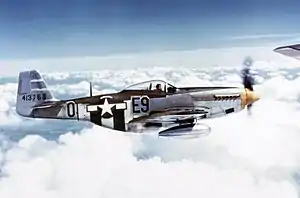| 376th Fighter Squadron | |
|---|---|
 Squadron P-51 Mustang | |
| Active | 1943–1945 |
| Country | |
| Branch | |
| Role | Fighter |
| Engagements | European Theater of Operations[1] |
| Insignia | |
| 376th Fighter Squadron emblem[note 1][1] |  |
| World War II fuselage code[2] | E9 |
The 376th Fighter Squadron is an inactive United States Air Force unit. Its last was assigned to the 361st Fighter Group, VIII Fighter Command, stationed at Camp Myles Standish, Massachusetts. It was inactivated on 23 October 1945. In 1985, the squadron was consolidated with the 376th Air Refueling Squadron
History
Established in early 1943 as the 376th Fighter Squadron and equipped with P-47 Thunderbolts, the squadron trained under I Fighter Command in the mid-Atlantic states. Also flew air-defense missions as part of the Philadelphia Fighter Wing. Deployed to the European Theater of Operations (ETO), being assigned to VIII Fighter Command in England, November 1943.
The unit served primarily as an escort organization, covering the penetration, attack, and withdrawal of B-17/B-24 bomber formations that the USAAF sent against targets on the Continent. The squadron also engaged in counter-air patrols, fighter sweeps, and strafing and dive-bombing missions. Attacked such targets as airdromes, marshalling yards, missile sites, industrial areas, ordnance depots, oil refineries, trains, and highways. During its operations, the unit participated in the assault against the Luftwaffe and aircraft industry during the Big Week, 20–25 February 1944, and the attack on transportation facilities prior to the Normandy invasion and support of the invasion forces thereafter, including the Saint-Lô breakthrough in July.
The squadron supported the airborne attack on the Netherlands in September 1944 and deployed to Chievres Airdrome, (ALG A-84), Belgium between February and April 1945 flying tactical ground support missions during the airborne assault across the Rhine. The unit returned to Little Walden and flew its last combat mission on 20 April 1945. Demobilized during the summer of 1945 in England, inactivated in the United States as a paper unit in October.
Lineage
- Constituted 376th Fighter Squadron on 28 January 1943
- Activated on 10 February 1943
- Inactivated on 10 November 1945[1]
Assignments
- 361st Fighter Group, 10 February 1943 – 10 November 1945[1]
Stations
|
|
Aircraft
- Republic P-47 Thunderbolt, 1943–1944
- North American P-51D Mustang, 1944–1945[1]
References
Notes
- Explanatory notes
- ↑ Approved 17 June 1943.
- Citations
Bibliography
![]() This article incorporates public domain material from the Air Force Historical Research Agency
This article incorporates public domain material from the Air Force Historical Research Agency
- Anderson, Capt. Barry (1985). Army Air Forces Stations: A Guide to the Stations Where U.S. Army Air Forces Personnel Served in the United Kingdom During World War II (PDF). Maxwell AFB, AL: Research Division, USAF Historical Research Center. Retrieved 1 March 2021.
- Freeman, Roger A. (1970). The Mighty Eighth: Units, Men and Machines (A History of the US 8th Army Air Force). London, England, UK: Macdonald and Company. ISBN 978-0-87938-638-2.
- Johnson, 1st Lt. David C. (1988). U.S. Army Air Forces Continental Airfields (ETO) D-Day to V-E Day (PDF). Maxwell AFB, AL: Research Division, USAF Historical Research Center. Archived from the original (PDF) on 29 September 2015. Retrieved 26 June 2017.
{{cite book}}: CS1 maint: numeric names: authors list (link) - Maurer, Maurer, ed. (1983) [1961]. Air Force Combat Units of World War II (PDF) (reprint ed.). Washington, DC: Office of Air Force History. ISBN 0-912799-02-1. LCCN 61060979.
- Maurer, Maurer, ed. (1982) [1969]. Combat Squadrons of the Air Force, World War II (PDF) (reprint ed.). Washington, DC: Office of Air Force History. ISBN 0-405-12194-6. LCCN 70605402. OCLC 72556.